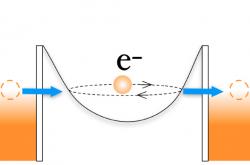
Scientists have designed a simple system to study how electrons travel through energy barriers instead of over them.
This unusual behavior, called tunneling, is the particle equivalent of a person being able to walk through rather than over a mountain. The particle behavior is also one of the most common signs that everyday physics has broken down and quantum mechanics now controls the system.
Duke physicist Gleb Finkelstein and his collaborators were manipulating the environment of tunneling electrons' using electrical leads and carbon nanotubes when they unexpectedly discovered they could create a quantum phase transition -- an abrupt change in the quantum state of the system. The team reports its findings Aug. 2 in the journal Nature.
"There are very few examples where you can see quantum phase transitions in a direct, controllable way. That is what is exciting here," said Duke theoretical physicist Harold Baranger, a co-author on the paper.
Quantum phases are similar to phases of matter in the everyday world, such as ice being a phase of water. But quantum phases occur at or near zero temperature,-459.67 degrees Fahrenheit, and usually happen when large groups of electrons and other particles change their characteristics collectively. Quantum phase transitions are ubiquitous in modern physics, but are hard to study. One of the most recognizable examples is found in superconducting materials, where electrons overcome their negative repulsion of each other and flow with little resistance.
In their experiment, the scientists were looking for signs of resonant tunneling, where the electrons hop onto the carbon nanotube on their way between the two electrical leads in the system. "Tunneling is like jumping across a creek," he said, adding that resonant tunneling is where "you have a small island, the resonant level inside the nanotube, to briefly plant your foot."
The team created an energy-draining environment in the leads and then measured how easily the electrons moved through the resonant level in the nanotube at ultra-low temperature. At the leads, "it's like the banks of the creek are swampy, so it takes energy to push yourself for a jump," said Finkelstein, who led the study.
If the resonant 'island' is positioned right between the two 'banks', then the electrons can easily hop between the banks. But if the island is closer to one of the banks, the electrons stay tied to either one of the leads. This difference in behavior, which was unexpected, signals a quantum phase transition, Finkelstein said.
The discovery might not make it into technology any time soon, but the lead experimenter, former Duke physics graduate student Henok Mebrahtu, does now work at Intel, Baranger said. The results also give scientists a simple system to begin testing a range of environments where quantum phase transitions can occur, he added.
Along with Baranger, Finkelstein and Mebrahtu, Ivan Borzenets, Dong Liu, Huaixiu Zheng and Yuriy Bomze of Duke and Alex Smirnov of North Carolina State University contributed to the work.
Citation: Quantum Phase Transition in a Resonant Level Coupled to Interacting Leads. Mebrahtu, H., et. al. Nature. 2012. 488:7409, 61-64.DOI: 10.1038/nature11265